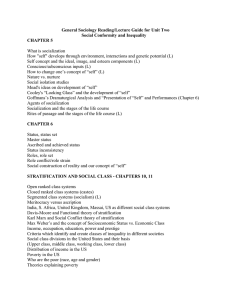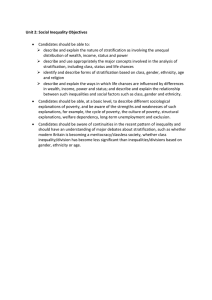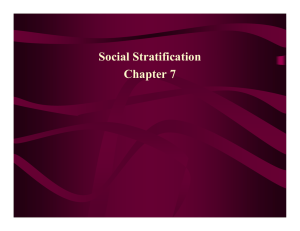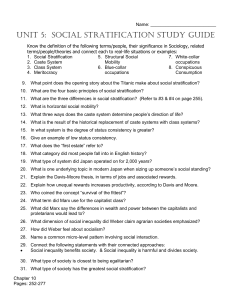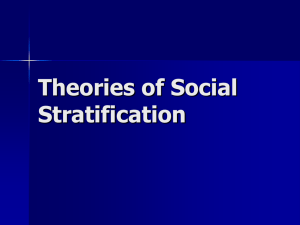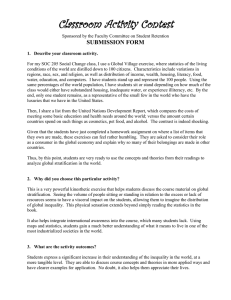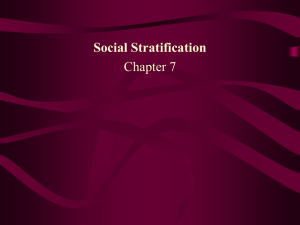Social Stratification: United States and Global Perspectives
advertisement
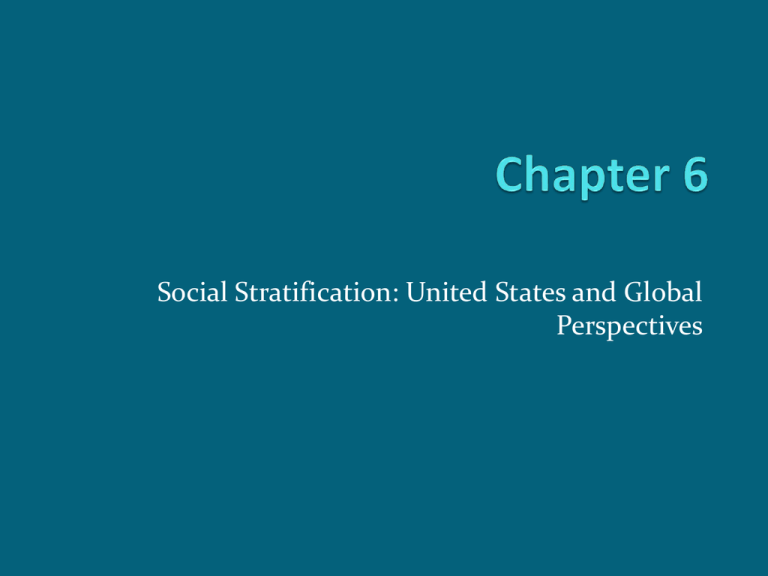
Social Stratification: United States and Global Perspectives Chapter Outline Social Stratification: Shipwrecks and Inequality Global Inequality Is Stratification Inevitable? Three Theories Social Mobility Noneconomic Dimensions of Class Social Stratification: Shipwrecks and Inequality Writers and filmmakers use the shipwreck as a literary device. It allows them to sweep away all traces of privilege and social convention and reveal human beings stripped to their essentials. Robinson Crusoe (1719) Defoe was one of the first writers to portray capitalism favorably. He believed that people get rich if they possess the virtues of good businessmen. Defoe tells the story of an Englishman marooned on a desert island. His strong will, hard work, and inventiveness turn the poor island into a thriving colony. Swept Away (1975) A yacht shipwrecks while on a cruise in the Mediterranean. The only survivors are a rich woman and a lowly deckhand. They fall in love. When they are rescued and return home, the woman turns her back on the deckhand, who is once again just a common laborer. Swept Away (1975) The movie sends three messages: 1. It is possible to be rich without working hard, because one can inherit wealth. 2. One can work hard without becoming rich. 3. Inequality disappears only on the desert island, without society as we know it. Social Stratification Refers to the way society is organized in layers or strata. Wealth vs. Income Wealth: what you own minus debts (e.g., a house minus the mortgage, a car minus the car loan, all funds in the bank) Income: what you earn in a given period 10 Richest Americans, 2010 Name Net Worth ($ billion) Source 1 Bill Gates 54 Microsoft Corp. 2 Warren Buffet 45 Berkshire Hathaway 3 Lawrence Joseph Ellison 27 Oracle Corp. 4 Christy Walton 24 Wal-Mart (inheritance) 21.5 Manufacturing (inheritance) 5 Charles Koch 10 Richest Americans, 2010 Name Net Worth ($ billion) 6 David Koch 21.5 7 Jim Walton 20.1 8 Alice Walton 20 9 S. Robinson Walton 19.7 10 Michael Bloomberg 18 Source Manufacturing (inheritance) Wal-Mart (inheritance) Wal-Mart (inheritance) Wal-Mart (inheritance) Bloomberg Average Wealth over Time Income Classes, 2009 Income Class % of Households Annual Income Upper-upper 1.5 $1 million + Lower-upper 15.2 $100,000-$999,999 Upper-middle 25.8 $60,000-$99,999 Income Classes, 2009 Income Class % of Households Annual Income Average-middle 21.4 $40,000-$59,999 Lower-middle or working- 17.0 $25,000-$39,999 Lower 19.1 $0-$24,999 Vertical Social Mobility Refers to movement up or down the stratification system. Distribution of National Income Among Households Patterns of Income Inequalities Income inequality has been increasing in the United States for a quarter of a century. 1974 - Top fifth of households earned 9.8 times more than the bottom fifth. 2009 - Top fifth of households earned 14.8 times more than the bottom fifth. 2009 - Top 20% of households earned more than the remaining 80%. Global Inequality 1/5 of the world’s population lacks shelter. More than 1/5 lacks safe water. 1/3 of the world’s people are without electricity. More 2/5 lack adequate sanitation. There are still about 27 million slaves in Mozambique, Sudan, and other African countries. Polling Question The citizens of poorer nations are more likely to be lazy when compared to the citizens of richer nations. a. b. c. d. e. Strongly agree Agree somewhat Unsure Disagree somewhat Strongly disagree U.N. Indicators of Human Development, Top 5 Countries, 2008-10 Country and Rank Life Expectancy Adult Literacy GDP/ Capita Norway 81.0 99% 58,278 Australia 81.9 99% 40,286 New Zealand 80.6 99% 27,520 United States 79.6 99% 46,653 Ireland 80.3 99% 38,768 U.N. Indicators of Human Development Bottom 5 Countries, 2008-10 Country and Rank Life Expectancy Adult Literacy GDP/ Capita Mozambique 48.4 46.2 929 Burundi 51.4 59.3 403 Niger 52.5 28.7 677 Congo 48 67.2 327 Zimbabwe 47 92.6 187 Global Inequality Refers to differences in the economic ranking of countries. Crossnational Variations in Internal Stratification Differences between countries in their stratification systems. Gini Index A measure of income inequality with a value ranging from zero to 1. A Gini index of zero indicates every household earns the same amount of money. A Gini index of 1 indicates that a single household earns the entire national income. Most countries have Gini indexes between 0.2 and 0.5. Household Income Inequality, 2000-08 Inequality and Development Foraging Societies Societies in which people live by searching for wild plants and hunting wild animals. Predominated until about 10,000 years ago. Inequality, the division of labor, productivity, and settlement size are very low in such societies. Horticultural and Pastoral Societies About 12,000 years ago, people established agricultural settlements based on horticulture and pastoralism. These innovations enabled people to produce a surplus above what they needed for subsistence. A small number of villagers controlled the surplus and significant social stratification emerged. Agricultural Societies People developed plow agriculture about 5,000 years ago and were able to increase production and surpluses. Agrarian societies developed religious beliefs justifying steeper inequality. People viewed large landowners as “lords.” If you were born a peasant, you and your children were likely to remain peasants. Stratification Systems Ascription-based stratification systems A stratification system in which the allocation of rank depends on the characteristics a person is born with. Achievement-based stratification system A stratification system in which the allocation of rank depends on a person’s accomplishments. Caste System An almost pure ascription-based stratification system in which occupation and marriage partners are assigned on the basis of caste membership. Apartheid A caste system based on race that existed in South Africa from 1948 until 1992. It consigned the black majority to menial jobs, prevented marriage between blacks and whites, and erected separate public facilities for members of the two races. Asians and people of “mixed race” enjoyed privileges between these two extremes. Industrial Societies Use machines and fuel to increase the supply of food and finished goods. Emerged about 225 years ago in Great Britain. Productivity, the division of labor, and settlement size increased substantially. Social inequality was substantial during early industrialism and declined as the industrial system matured. Postindustrial Societies Societies in which most workers are employed in the service sector and computers spur increases in the division of labor and productivity. Shortly after World War II, the U.S. became the first postindustrial society. Gender inequality is reduced because so many women are brought into higher education and the paid labor force. Conflict Theory: Marx A person’s class is determined by the source of his or her income: The bourgeoisie owns the means of production. The proletariat do physical labor. Workers would develop class consciousness and recognize their exploitation and try to create a new “communist” society Critical Evaluation of Marx Industrial societies did not polarize into two opposed classes engaged in bitter conflict; rather a large middle class emerged Investment in technology not only leads to profit but also higher wages and fewer work hours Communism emerged in semi-industrialized countries and new forms of stratification emerged Functionalism: The Davis-Moore Thesis Argues that: some jobs are more important than others people have to make sacrifices to train for important jobs inequality is required to motivate people to undergo these sacrifices. Criticisms of Functionalism Inequality encourages the discovery of talent only for those who can afford to take advantage of the opportunities available to them. Once people attain high-class standing, they can use their power to maintain their position and promote the interests of their families regardless of their children’s talent. Theories of Stratification: Weber Four main classes: large property owners small property owners propertyless but relatively highly educated and well-paid employees propertyless manual workers Status Groups Groups that differ from one another in terms of the prestige or social honor they enjoy and in terms of their lifestyle. Weber’s Stratification Scheme Parties In Weber’s usage, organizations that seek to impose their will on others. Mean Annual Earnings and Prestige Scores, Selected Occupations, U.S. Occupation Physicians Lawyers Airline pilots Aerospace Engineers Computer Programmers Median Annual Income 2009 173,860 129.020 117,060 Prestige Score, 1989 86 75 61 96,270 72 74,690 61 Mean Annual Earnings and Prestige Scores, Selected Occupations, U.S. Occupation Janitors Restaurant Cooks Sewing Machine Operators Secretaries Median Annual Income 2009 24,120 Prestige Score, 1989 22 23,110 31 22,250 28 21,035 46 Blau and Duncan’s Status Attainment Looked at the relative importance of inheritance versus individual merit in determining one’s place in the stratification system Socioeconomic index (SEI) of occupational status An index developed by Blau and Duncan that combines, for each occupation, average earnings and years of education of men employed full time in the occupation. Socioeconomic status (SES) Combines income, education, and occupational prestige data in a single index of one’s position in the socioeconomic hierarchy. Blau and Duncan’s Model of Occupational Achievement Structural Mobility Social mobility that results from changes in the distribution of occupations. Intragenerational mobility Social mobility that occurs within a single generation. Intergenerational mobility Social mobility that occurs between generations. Poverty Rate The percentage of people living below the poverty threshold, which is three times the minimum food budget established by the U.S. Department of Agriculture. Government Policy and the Poverty Rate in the U.S. Fluctuations in the poverty rate are related to political events. Between 1961 and 2009: The poverty rate fell in 16 of the 21 years in which the president was a Democrat (76%) but in only 14 of the 28 years in which the president was a Republican (50%). Polling Question Many poor people simply don't want to work hard. a. b. c. d. e. Strongly agree Agree somewhat Unsure Disagree somewhat Strongly disagree Myths about the poor 1. The majority of poor people are African- or HispanicAmerican single mothers with children. In 2009, fully 43% of the poor were non-Hispanic whites Female-headed families represented 47% of the poor. Myths about the poor 2. People are poor because they don’t want to work. More than 11% of the poor over age 15 worked in 2009. 43% of poor people are under age 18 or over 65. Many of the poor are unable to work due to health or disability issues. Myths about the poor 3. Poor people are trapped in poverty. Poverty population is dynamic Only about 12% of the poor remain poor 5 or more years in a row Myths about the poor 4. Welfare encourages married women with children to divorce so they can collect welfare, and it encourages single women on welfare to have more children. Women on welfare have a lower birthrate than women in the general population. Welfare payments are very low and recipients suffer severe economic hardship. Myths about the poor 5. Welfare is a strain on the federal budget and does little to decrease the poverty rate. Welfare spending amounts to less than 11% of the federal budget (compared to 17% in the U.K.) Job-training and child care programs allow many poor people to take jobs Poverty in the U.S., 2009 1. One’s wealth includes which of the following: a. b. c. d. Earnings from work House minus mortgage Car minus car loan Answers b and c Answer: d One’s wealth includes: house minus mortgage and car minus car loan. 2. Since the early 1960s: a. b. c. more downward than upward mobility has occurred in the United States the amount of downward and upward mobility has been about equal more upward than downward mobility has occurred in the United States, and the gap between upward and downward mobility started to shrink when many Americans reported deterioration in their economic situation Answer: c 1. Since the early 1960s: more upward than downward mobility has occurred in the United States, and the gap between upward and downward mobility started to shrink when many Americans reported deterioration in their economic situation. 3. For Marx, the bourgeoisie: a. b. c. d. own the means of production do not do any physical labor own the means of production and do physical work themselves own the means of production, and do not do any physical labor Answer: d For Marx, the bourgeoisie own the means of production, and do not do any physical labor. 4. Which of the following is not one of the major classes in capitalist society according to Weber? a. b. c. d. large property owners small property owners service workers property-less but educated and well-paid employees Answer: c Service workers are not one of the major classes in capitalist society according to Weber. 5. According to the functional theory of stratification, social inequality is necessary because the prospect of high material rewards motivates people to undergo the sacrifices needed to get a higher education. a. b. True False Answer: True According to the functional theory of stratification, social inequality is necessary because the prospect of high material rewards motivates people to undergo the sacrifices needed to get a higher education.

